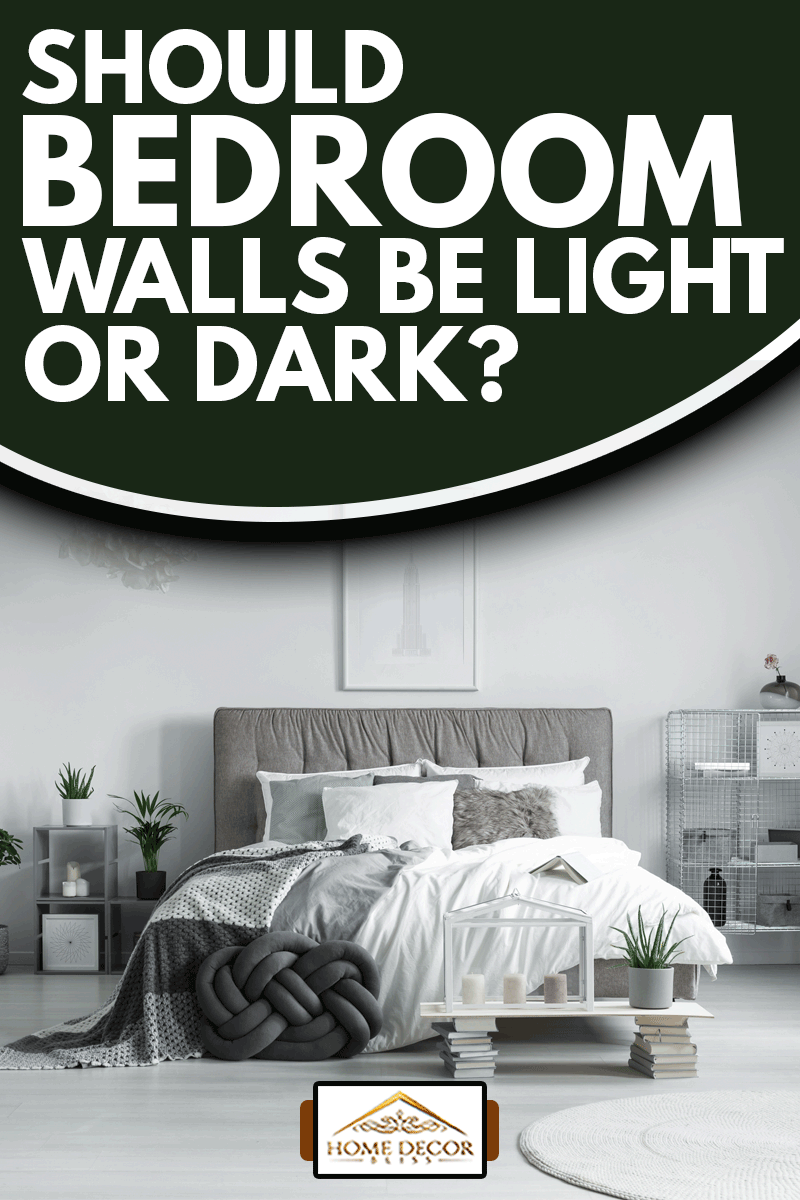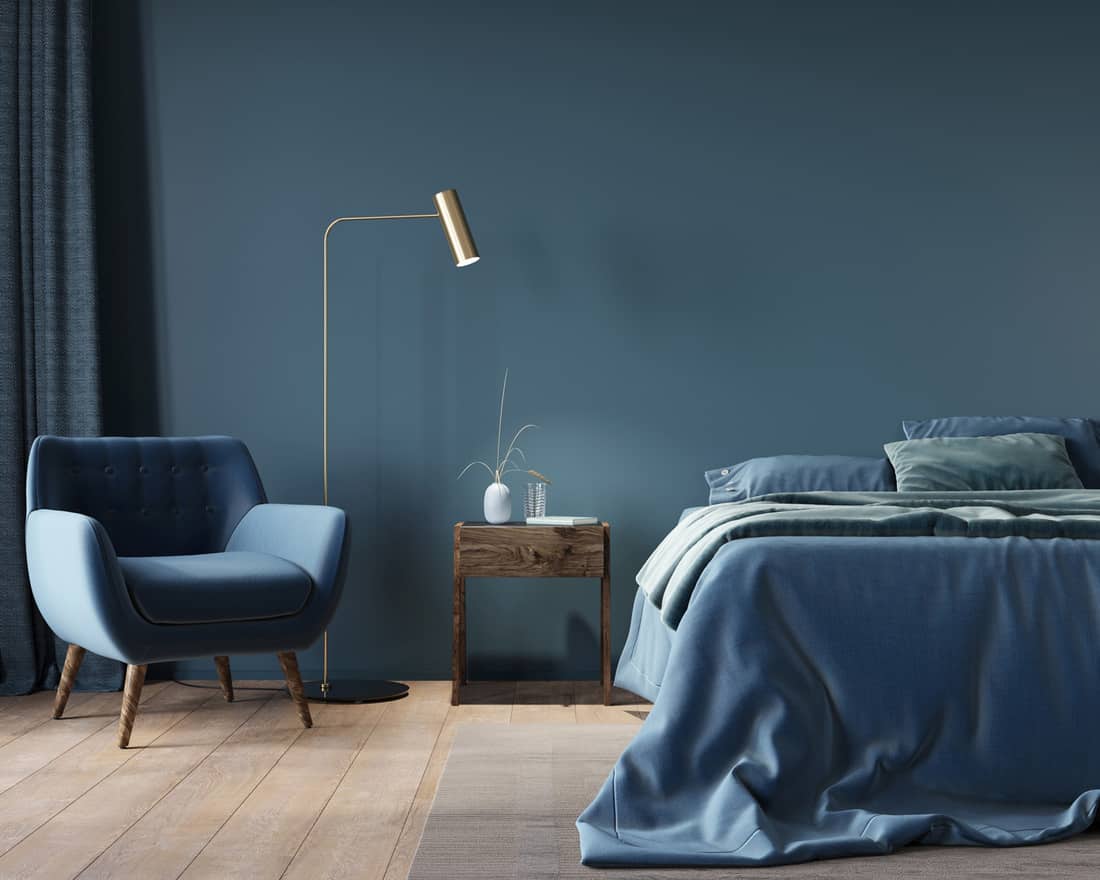Dark Vs Light Bedroom
If you're updating your bedroom or decorating a new one, you may be wondering if you should paint your walls light or go with one of the dark, moody colors that seem so trendy right now. We've done all the research to find out what designers think is the best option, and we have answers for you.
Whether you should paint your bedroom dark or light depends on what type of lighting you have and how big your room is. If you have a lot of natural light or a large room, light color is a great option. If your natural light is limited or your room is small, a dark color will work better.
Despite the conventional wisdom that dark colors make a room seem smaller, it actually depends more on the type of light you have. Continue reading to find out more details about using light or dark colors in your bedroom, as well as if you should go with warm or cool colors.

Light Versus Dark Bedroom Wall Colors
Use a Light Color if Your Bedroom Has Good Natural Light or Is Large

It's natural to think that a light color will brighten up a room. However, the truth is that good quality light is what makes a room look brighter. A light color in a room without enough natural light will look dull and flat with a grayish hue.
For bedrooms that have many windows, choosing a light color will enhance the lightness and airiness of the room. Large rooms also look great with light colors since dark colors can be overpowering in large spaces.
Use a Dark Color if Your Bedroom Doesn't Get Much Light or is Small

Dark colors look dramatic and rich in small bedrooms. Many people think dark colors make a room look smaller, but they don't. Dark colors tend to disguise the lines of a room so it can actually make it look bigger. Dark colors will also give your bedroom a cozy feel.
Using dark colors in a bedroom that doesn't get much natural light will emphasize the cozy feel. Artificial light looks better on darker colors than it does on lighter colors. The undertones of artificial colors can look harsh and contrasty on light colors, whereas dark colors don't show color casts as much.
What Are Warm Colors vs. Cool Colors?
To understand color temperature, it helps to talk about the color wheel. The color wheel contains the visible colors of the spectrum, which are red, orange, yellow, green, blue, indigo, and violet.

The warm colors are on the half of the color wheel that contains red, orange, and yellow shades. These are the colors of sunshine and warmth. Warm colors are stimulating and energizing.
The cool colors are on the other half of the color wheel, the greens, and blues. These are calming, relaxing colors you associate with water and nature.
Purple and green are usually considered cool, but they can be warm if they're predominantly mixed with a warm color. Purples that have more red than blue have the characteristics of warm colors. Greens that are bright and contain a lot of yellow are also warm colors.

Click here to check out this color reference wheel on Amazon.
Neutral colors can be either warm or cool, depending on their shades and undertones. Beiges are usually warm, while grays are often cool.
Color alone doesn't tell the whole story, though. To better understand color theory, it helps to understand a few terms. Hue refers to the color itself, such as red or blue. A tint is a color that has white added to it, such as a pastel pink. A shade is a color that has black added to it. A tone is a color that has gray added to it. Toning a color dulls its intensity, which can be useful if you love a dramatic orange but feel like it's overwhelming.
Warm colors often become relaxing when they're tinted or toned. Pastel pink is a great example. If you want a calm color in your bedroom but have your heart set on a warm color, tinting it is a good compromise.

Should You Choose Warm or Cool Colors for Your Bedroom?
Cool colors are usually the best for bedrooms. Since warm colors are energizing and exciting, it's a good idea to avoid using them in rooms you want to relax and sleep in. Your bedroom should be an oasis of calm. You can pick light and airy, cool colors such as white with just a touch of blue, or you can go with a dark, moody, deep green. There are relaxing, soothing, cool colors in a variety of tints, shades, and tones.

Click here to shop for a painting kit at Amazon.
What Is the Most Relaxing Color to Paint a Bedroom?
According to a global survey of over 26,000 people in over 100 countries, navy blue is the most relaxing color, followed by light teal and pastel pink. Navy blue is no surprise since it's a dark, cool color often used as a neutral. Teal brings to mind relaxing on a white sand beach with the waves crashing in the distance. Though technically a warm color, pastel pink has been tinted enough to be relaxing rather than invigorating.
For a small bedroom, the most relaxing color to use is navy blue. This will give you a calming hue that will actually make your room appear bigger since the borders will fade into the shadows. If your room is bigger, you can go with a teal or light pink to give it a relaxing feel without overpowering it with a dark color.

Does a Dark Room Help You Sleep Better?
Darkness is essential for getting a good night's sleep. Exposure to light at the wrong time upsets your body's internal clock and interferes with your ability to sleep. Painting your bedroom a dark color will help your body prepare for sleep.
Another tip for creating a bedroom that will help you sleep is to use flat paint, regardless of what color you choose. Semigloss and gloss paint colors reflect light and may disturb your rest.
You may need to take additional steps to keep your room dark, however. Turn out artificial lights when you go to bed. If your windows let in a lot of light, either moonlight or artificial street lights, you might want to consider blackout curtains. Additionally, you can install some motion-activated red nightlights. They aren't on when you don't need them. When you do, the red light is the least disturbing type of light.

Click here to see motion-activated red night lights at Amazon.
What Colors Are Not Good for a Bedroom?
If you're in love with a particular color, you can probably find a way to incorporate it into your bedroom. However, some colors aren't conducive to a good night's sleep.
Bright Purple
Although purple can be a cool color, bright purple is very energizing due to its reddish undertones. If you want to use purple in your bedroom, choose a lighter tint that will be more soothing.
Red
Red is another color you should avoid in your bedroom. Red is a very dramatic power color, which is the opposite of the feeling you want to generate when you're trying to get to sleep.
Brown
Brown can be associated with feelings of loneliness and isolation. Under the right circumstances, brown can feel solid and reassuring, but because of its connection with depression, it's best to avoid it in the bedroom.
Gray
While gray can be gorgeous, smoky, and dramatic, it is also a dreary color at times. You want to feel peaceful, calm, and relaxed when you're in your bedroom. Avoiding colors that can induce feelings of melancholy at bedtime will help you sleep more soundly. If you choose gray, go for a light gray with blue undertones to take advantage of the more relaxing hue.

Final Thoughts
It's important to consider good sleep hygiene and not just style when you're designing your bedroom. That bedroom that looked dreamy on Pinterest may turn into a nightmare if you can't get a good night's sleep in it. The good news is that by varying hues, shades, tones, or tints, you can find a way to make almost any color work to create the bedroom of your dreams.
If you're designing a bedroom, you may enjoy these articles as well:
11 Bedroom Rug Placement Ideas To Inspire You
11 Gorgeous Sloped Ceiling Bedroom Ideas
Source: https://homedecorbliss.com/should-bedroom-walls-be-light-or-dark/
